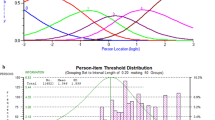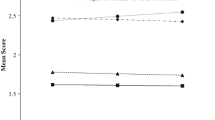Abstract
This study focuses on the factor structure of a multidimensional loneliness measure, that is, the Loneliness and Aloneness Scale for Children and Adolescents (LACA). Confirmatory factor analyses were conducted on a large sample of children and adolescents (N = 9,676) in Belgium. Results indicated that the supposed four-factor structure of the instrument showed a superior fit when compared to alternative, more parsimonious models. Measurement invariance was established across gender and across all age groups in the intended age range (i.e., elementary school to freshman year in college). Age comparisons indicated that parent-related loneliness and positive attitudes to aloneness increased throughout adolescence. In sum, the present study offers strong support based on strict tests for the factor structure of a particular multidimensional loneliness measure (LACA). Future research should extend such analyses to other multidimensional measures of loneliness.
Similar content being viewed by others
References
Bollen, K. A. (1989). Structural equations with latent variables. New York, NY: Wiley.
Bossaert, G., Colpin, H., Pijl, S. J., & Petry, K. (2012). Loneliness among students with special educational needs in mainstream seventh grade. Research in Developmental Disabilities, 33, 1888–1897. doi:10.1016/j.ridd.2012.05.010.
Chen, F. F. (2007). Sensitivity of goodness of fit indexes to lack of measurement invariance. Structural Equation Modeling, 14, 464–504. doi:10.1080/10705510701301834.
Chen, C. C.-H., Chyun, D. A., Li, C.-Y., & McCorkle, R. (2007). A single-item approach to screening elders for oral health assessment. Nursing Research, 56, 332–338. doi:10.1097/01.NNR.0000289504.30037.d8.
Cheung, G. W., & Rensvold, R. B. (2002). Evaluating goodness-of-fit indexes for testing measurement invariance. Structural Equation Modeling, 9, 233–255. doi:10.1207/S15328007SEM0902_5.
Corsano, P., Majorano, M., & Champretavy, L. (2006). Psychological well-being in adolescence: the contribution of interpersonal relations and experience of being alone. Adolescence, 41, 341–353.
Cramer, K. M., & Barry, J. E. (1999). Conceptualizations and measures of loneliness: A comparison of subscales. Personality and Individual Differences, 27, 491–502. doi:10.1016/S0191-8869(98)00257-8.
De Roiste, A. (2000). Peer and parent-related loneliness in Irish adolescents. The Irish Journal of Psychology, 21, 237–246. doi:10.1080/03033910.2000.10558256.
DiTommaso, E., Brannen, C., & Best, L. A. (2004). Measurement and validity characteristics of the short version of the Social and Emotional Loneliness Scale for Adults. Educational and Psychological Measurement, 64, 99–119. doi:10.1177/0013164403258450.
DiTommaso, E., & Spinner, B. (1993). The development and initial validation of the Social and Emotional Loneliness Scale for Adults (SELSA). Personality and Individual Differences, 14, 127–134. doi:10.1016/0191-8869(93)90182-3.
Furman, W., & Buhrmester, D. (1992). Age and sex differences in perceptions of networks of personal relationships. Child Development, 63, 103–115. doi:10.2307/1130905.
Goossens, L. (Ed.) (2013). Leuvense Eenzaamheidsschaal voor Kinderen en Adolescenten: Handleiding [Loneliness and Aloneness Scale for Children and Adolescents: Manual]. Unpublished manuscript, Department of School Psychology and Child and Adolescent Development, KU Leuven, Belgium.
Goossens, L., & Beyers, W. (2002). Comparing measures of childhood loneliness: Internal consistency and confirmatory factor analysis. Journal of Clinical Child and Adolescent Psychology, 31, 252–262. doi:10.1207/153744202753604520.
Goossens, L., Lasgaard, M., Luyckx, K., Vanhalst, J., Mathias, S., & Masy, E. (2009). Loneliness and solitude in adolescence: A confirmatory factor analysis of alternative models. Personality and Individual Differences, 47, 890–894. doi:10.1016/j.paid.2009.07.011.
Goossens, L., & Marcoen, A. (1999). Adolescent loneliness, self-reflection, and identity: From individual differences to developmental processes. In K. J. Rotenberg & S. Hymel (Eds.), Loneliness in childhood and adolescence (pp. 225–243). New York, NY: Cambridge University Press.
Hambleton, R. K. (1994). Guidelines for adapting educational and psychological tests: A progress report. European Journal of Psychological Assessment, 10, 229–244.
Hartmann, L. A. (1991). Friendship development in early adolescence: Experience, expectations, and aspects of loneliness (Unpublished doctoral dissertation). Oxford, OH: Miami University.
Heinrich, L. A., & Gullone, E. (2006). The clinical significance of loneliness: A literature review. Clinical Psychology Review, 26, 695–718. doi:10.1016/j.cpr.2006.04.002.
Houghton, S., Hattie, J., Wood, L., Carroll, A., Martin, K., & Tan, C. (2013). Conceptualising loneliness in adolescents: Development and validation of a self-report instrument. Child Psychiatry and Human Development. Advance online publication. doi:10.1007/s10578-013-0429-z.
Hu, L., & Bentler, P. M. (1999). Cutoff criteria for fit indexes in covariance structure analysis: Conventional criteria versus new alternatives. Structural Equation Modeling, 6, 1–55. doi:10.1080/10705519909540118.
Larson, R. W. (1997). The emergence of solitude as a constructive domain of experience in early adolescence. Child Development, 68, 80–93. doi:10.1111/j.1467-8624.1997.tb01927.x.
Lasgaard, M., Goossens, L., Bramsen, R. H., Trillingsgaard, T., & Elklit, A. (2011). Different sources of loneliness are associated with different forms of psychopathology in adolescence. Journal of Research in Personality, 45, 233–237. doi:10.1016/j.jrp.2010.12.005.
Little, R. J. A. (1988). A test of missing completely at random for multivariate data with missing values. Journal of the American Statistical Association, 83, 1198–1202. doi:10.2307/2290157.
Little, T. D., Cunningham, W. A., Shahar, G., & Widaman, K. F. (2002). To parcel or not to parcel: Exploring the question, weighing the merits. Structural Equation Modeling, 9, 151–173. doi:10.1207/S15328007sem0902_1.
Marcoen, A., & Goossens, L. (1993). Loneliness, attitude toward aloneness, and solitude: Age differences and developmental significance during adolescence. In S. Jackson & H. Rodriguez-Tome (Eds.), Adolescence and its social worlds (pp. 197–227). Hove, UK: Erlbaum.
Marcoen, A., Goossens, L., & Caes, P. (1987). Loneliness in pre through late adolescence: Exploring the contributions of a multidimensional approach. Journal of Youth and Adolescence, 16, 561–577. doi:10.1007/bf02138821.
Marsh, H. W., & Hau, K.-T. (1999). Confirmatory factor analysis: Strategies for small sample sizes. In R. H. Hoyle (Ed.), Statistical strategies for small sample research (pp. 251–284). Thousand Oaks, CA: Sage.
McNamara, J. K., Willoughby, T., & Chalmers, H. (2005). Psychosocial status of adolescents with learning disabilities with and without comorbid attention deficit hyperactivity disorder. Learning Disabilities Research and Practice, 20, 234–244. doi:10.1111/j.1540-5826.2005.00139.x.
Melotti, G., Corsano, P., Majorano, M., & Scarpuzzi, P. (2006). An Italian application of the Louvain Loneliness Scale for Children and Adolescents (LLCA). Testing Psychometrics Methodology in Applied Psychology, 13, 237–254.
Musetti, A., Corsano, P., Majorano, M., & Mancini, T. (2012). Idenitty processes and experience of being alone during late adolescence. International Journal of Psychoanalysis and Education, 4, 44–65.
Muthén, L. K., & Muthén, B. O. (2007). Mplus user’s guide (4th ed.). Los Angeles, CA: Muthén & Muthén.
Perlman, D., & Peplau, L. A. (1981). Toward a social psychology of loneliness. In S. Duck & R. Gilmour (Eds.), Personal relationships in disorder (Vol. 3, pp. 31–56). London, UK: Academic Press.
Qualter, P., Brown, S. L., Munn, P., & Rotenberg, K. J. (2010). Childhood loneliness as a predictor of adolescent depressive symptoms: An 8-year longitudinal study. European Child and Adolescent Psychiatry, 19, 493–501. doi:10.1007/s00787-009-0059-y.
Russell, D. (1982). The measurement of loneliness. In L. A. Peplau & D. Perlman (Eds.), Loneliness: A sourcebook of current theory, research and therapy (pp. 81–104). New York, NY: Wiley.
Russell, D., Peplau, L. A., & Cutrona, C. E. (1980). The revised UCLA loneliness scale: Concurrent and discriminant validity evidence. Journal of Personality and Social Psychology, 39, 472–480. doi:10.1037/0022-3514.39.3.472.
Satorra, A., & Bentler, P. M. (1994). Corrections to test statistics and standard errors in covariance structure analysis. In A. V. Eye & C. C. Clogg (Eds.), Latent variables analysis: Applications for developmental research (pp. 399–419). Thousand Oaks, CA: Sage.
Scharf, M., Wiseman, H., & Farah, F. (2011). Parent-adolescent relationships and social adjustment: The case of a collectivistic culture. International Journal of Psychology, 46, 177–190. doi:10.1080/00207594.2010.528424.
Schmitt, J. P., & Kurdek, L. A. (1985). Age and gender differences in and personality correlates of loneliness in different relationships. Journal of Personality Assessment, 49, 485–496. doi:10.1207/s15327752jpa4905_5.
Terrell-Deutsch, B. (1999). The conceptualization and measurement of childhood loneliness. In K. J. Rotenberg & S. Hymel (Eds.), Loneliness in childhood and adolescence (pp. 11–33). New York, NY: Cambridge University Press.
Van de Schoot, R., Lugtig, P., & Hox, J. (2012). A checklist for testing measurement invariance. European Journal of Developmental Psychology, 9, 486–492. doi:10.1080/17405629.2012.686740.
Van Roekel, E., Scholte, R. H., Verhagen, M., Goossens, L., & Engels, R. C. (2010). Loneliness in adolescence: Gene x environment interactions involving the serotonin transporter gene. Journal of Child Psychology and Psychiatry, 51, 747–754. doi:10.1111/j.1469-7610.2010.02225.x.
Vandenberg, R. J., & Lance, C. E. (2000). A review and synthesis of the measurement invariance literature: Suggestions, practices, and recommendations for organizational research. Organizational Research Methods, 3, 4–70. doi:10.1177/109442810031002.
Author information
Authors and Affiliations
Corresponding author
Rights and permissions
About this article
Cite this article
Maes, M., Klimstra, T., Van den Noortgate, W. et al. Factor Structure and Measurement Invariance of a Multidimensional Loneliness Scale: Comparisons Across Gender and Age. J Child Fam Stud 24, 1829–1837 (2015). https://doi.org/10.1007/s10826-014-9986-4
Published:
Issue Date:
DOI: https://doi.org/10.1007/s10826-014-9986-4




